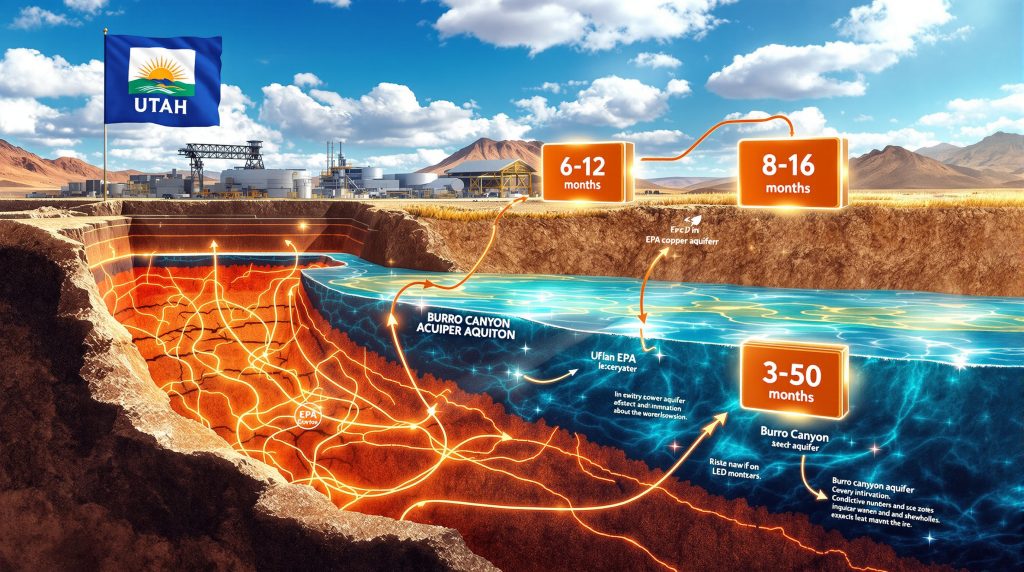Understanding Federal Environmental Oversight in Mining Operations
The Environmental Protection Agency's regulatory framework for copper extraction projects represents a complex intersection of environmental protection and domestic mineral security. Recent developments in Utah demonstrate how federal agencies balance these competing priorities through comprehensive evaluation processes that examine groundwater protection, environmental impact assessment, and multi-agency coordination.
The EPA approval for copper mining project in Utah gained significant attention in October 2025 with the approval of an aquifer exemption for copper mining operations in Utah's San Juan County. This decision, coordinated with the Utah Department of Environmental Quality, reflects the Trump admin mineral order focus on strengthening domestic mineral production capabilities while maintaining environmental safeguards.
How Underground Injection Control Programs Enable Mining Operations
Mining companies pursuing in-situ recovery methods must navigate the Underground Injection Control program, which typically prohibits fluid injection into underground formations. The UIC framework creates specific pathways for mining operations through carefully structured exemption processes.
Commercial Mineral Viability Requirements
The exemption process requires detailed demonstration of commercially viable mineral deposits. For the Burro Canyon aquifer exemption, operators provided comprehensive geological assessments showing copper concentrations suitable for solution mining techniques. This scientific foundation supports EPA approval for copper mining project in Utah determinations that mineral extraction represents the highest and best use of specific underground formations.
Water Source Evaluation Criteria
Federal agencies evaluate current and projected drinking water usage patterns when considering aquifer exemptions. The Burro Canyon formation's characteristics, including existing water quality parameters and accessibility limitations, influenced EPA's determination that the affected portion does not serve as a drinking water source.
Key evaluation factors include:
- Current municipal and private well usage patterns
- Projected population growth and water demand
- Alternative water source availability
- Geological characteristics affecting water accessibility
Regulatory Coordination Between Federal and State Agencies
The approval process demonstrates sophisticated coordination between multiple government levels, with each agency contributing specialised expertise to comprehensive environmental review. Furthermore, this coordination integrates modern mine planning & ESG principles throughout the evaluation process.
Utah Department of Environmental Quality's Role
UDEQ Executive Director Tim Davis emphasised the state's commitment to protecting air quality, land health, and water safety while supporting responsible economic development. The state agency issued the Class III injection well permit following thorough environmental review and stakeholder consultation processes.
State-level responsibilities encompass:
- Local environmental compliance monitoring
- Stakeholder engagement coordination
- Regional water resource protection
- Economic impact assessment for local communities
Federal Agency Oversight Functions
EPA Regional Administrator Cyrus Western highlighted the federal commitment to advancing economic growth while maintaining environmental protection standards. The agency's review process examined interstate environmental impacts and national mineral security considerations.
Federal oversight includes:
- Aquifer exemption authorisation decisions
- National environmental standard enforcement
- Cross-border environmental impact evaluation
- Strategic mineral security assessment
FAST-41 Streamlined Permitting Framework
The Lisbon Valley Copper Mine expansion operates under the Fixing America's Surface Transportation Act's transparency provisions, creating enhanced federal coordination mechanisms that reduce bureaucratic inefficiencies. Moreover, understanding permitting essentials becomes crucial for project success.
Enhanced Agency Coordination
Title 41 inclusion provides transparent timeline tracking through federal dashboard systems, enabling improved communication between agencies and more predictable approval schedules. This framework supports investment planning by reducing regulatory uncertainty.
FAST-41 benefits include:
- Real-time permitting progress tracking
- Coordinated agency review schedules
- Reduced administrative delays
- Enhanced public transparency
Bureau of Land Management Integration
The EPA's decision aligns with BLM approval of expanded copper mining operations, demonstrating comprehensive federal support for domestic mineral production. The coordinated approach ensures consistent regulatory standards across multiple federal jurisdictions.
BLM's approval enables underground copper extraction targeting production exceeding 500 million pounds of copper, representing substantial economic value for American mineral independence initiatives. Additionally, this production aligns with broader copper supply forecast projections for 2025.
Environmental Safeguards in Modern Solution Mining
Contemporary copper extraction utilises advanced technological systems designed to minimise environmental impact while maximising resource recovery efficiency. Consequently, innovative mine reclamation techniques play an essential role in sustainable operations.
Underground Recovery Technology
In-situ solution mining dissolves copper minerals underground using carefully controlled chemical processes, eliminating traditional surface mining disturbances. This approach offers significant environmental advantages over conventional extraction methods.
Process advantages include:
- Minimal surface landscape disruption
- Reduced waste rock generation
- Lower dust and noise production
- Decreased transportation requirements
Water Resource Protection Systems
Modern mining operations incorporate multiple protection layers designed to safeguard groundwater quality and prevent contamination of adjacent water sources.
"Critical Protection Measures: Advanced monitoring systems provide real-time groundwater quality assessment, while automated leak detection technology enables immediate response to potential issues."
Comprehensive protection systems feature:
- Continuous groundwater monitoring networks
- Double-lined storage and processing facilities
- Emergency containment and response protocols
- Regular third-party environmental auditing
Strategic Importance for American Mineral Security
Copper represents a critical material for infrastructure development, renewable energy installations, and technological advancement. Domestic production reduces reliance on international suppliers while supporting strategic economic objectives.
Infrastructure Development Applications
Copper's essential role in electrical systems, telecommunications networks, and renewable energy infrastructure makes domestic production a national security priority. The approved expansion directly supports American infrastructure modernisation efforts.
Key applications include:
- Electrical grid modernisation projects
- Renewable energy system installations
- Telecommunications infrastructure expansion
- Transportation electrification initiatives
Economic Impact Assessment
The expanded mining operations create substantial economic opportunities for local communities while contributing to national mineral independence objectives.
| Economic Metric | Projected Impact | Regional Significance |
|---|---|---|
| Annual Production Capacity | 500+ million pounds | Major domestic supply contribution |
| Direct Employment Creation | 200-400 positions | Significant local job market impact |
| Estimated Tax Revenue | $5-10 million annually | Community infrastructure funding |
| Supply Chain Benefits | Reduced import dependence | Enhanced manufacturing sector support |
Technical Aspects of Aquifer Exemption Decisions
EPA's exemption determination relies on comprehensive geological, hydrological, and environmental analysis to ensure appropriate regulatory decisions. For instance, the EPA's official approval documentation provides detailed technical specifications.
Geological Formation Characteristics
The Burro Canyon formation presents specific geological conditions that support mining exemption approval. Scientific analysis revealed mineral concentrations, water quality parameters, and geological isolation factors that minimise environmental risks.
Critical geological factors:
- Commercial-grade copper concentration levels
- Limited connectivity to drinking water sources
- Appropriate geological containment characteristics
- Suitable formation depth and accessibility
Long-term Environmental Monitoring
Mining operations must demonstrate ongoing environmental stewardship through comprehensive monitoring and restoration programs extending beyond active production phases.
Monitoring requirements include:
- Continuous groundwater quality assessment
- Progressive site rehabilitation during operations
- Post-closure monitoring commitments
- Financial bonding for environmental restoration
Policy Evolution Supporting Critical Mineral Production
Federal policy increasingly prioritises domestic mineral production through streamlined regulatory processes and enhanced federal-state coordination mechanisms. However, the EPA approval for copper mining project in Utah reflects broader policy shifts towards mineral independence.
What Changes Has the Trump Administration Made to Mineral Independence?
The current administration's focus on American mineral independence creates supportive policy frameworks for domestic mining operations while maintaining environmental protection standards.
Policy initiatives encompass:
- Expedited permitting for strategic minerals
- Enhanced interagency coordination protocols
- Investment incentives for domestic production
- Reduced regulatory barriers for critical materials
Future Regulatory Trends
Advancing technology integration in environmental monitoring creates opportunities for more sophisticated regulatory oversight while supporting efficient mining operations.
Emerging trends include:
- Satellite-based environmental surveillance systems
- Artificial intelligence analysis for early issue detection
- Blockchain documentation for transparency enhancement
- Automated compliance tracking and reporting
Stakeholder Engagement in Mining Approvals
Successful project approval requires comprehensive consultation with diverse stakeholder groups, including tribal nations, local communities, and environmental organisations. Furthermore, this process demonstrates the EPA approval for copper mining project in Utah commitment to transparency.
Community Consultation Processes
Mining companies must demonstrate meaningful engagement with affected communities, addressing concerns about environmental impacts, economic benefits, and long-term sustainability.
Stakeholder engagement elements:
- Public hearing and comment periods
- Environmental impact disclosure
- Economic benefit sharing discussions
- Cultural resource protection consultations
Tribal Nation Coordination
Projects affecting areas with historical tribal connections require specialised consultation processes respecting sovereignty and cultural significance. In addition, tribal consultation often involves considerations of copper mining's broader impacts on sacred sites and traditional resources.
Balancing Development with Environmental Stewardship
The EPA's Utah copper mining approval demonstrates evolving approaches to natural resource development that integrate economic growth objectives with comprehensive environmental protection standards.
Through sophisticated regulatory frameworks, advanced monitoring technologies, and multi-stakeholder engagement processes, modern mining operations contribute to national mineral security while maintaining strict environmental safeguards. This balanced approach ensures sustainable resource development supporting both immediate economic benefits and long-term environmental protection.
The successful coordination between federal and state agencies in this approval process establishes precedents for future critical mineral projects, supporting American mineral independence while protecting environmental resources for future generations.
Disclaimer: This analysis is based on publicly available information as of October 2025. Mining project details, regulatory timelines, and economic projections may change based on ongoing developments and market conditions. Readers should consult current regulatory documents and official agency statements for the most up-to-date information.
Want to Stay Ahead of Major Mineral Discoveries?
Discovery Alert's proprietary Discovery IQ model delivers instant notifications on significant ASX mineral discoveries, helping investors identify actionable opportunities before the broader market catches on. Explore how historic discoveries have delivered substantial returns and begin your 30-day free trial today to gain your competitive market advantage.




